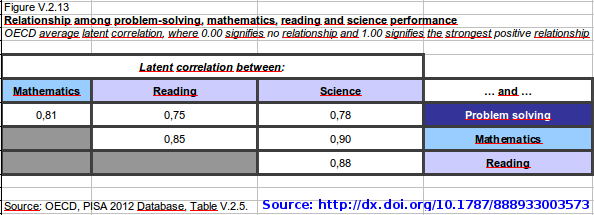Reviewing the last PISA report (2014) about «Are 15-year-olds creative problem-solvers?» available at European Schoolnet Academy (PDF) site, I found this figure:
It shows the latent correlation between performance in Mathematics, Reading, Science and Problem-solving. Probably nothing unexpected in the overall data but I’d like to highlight, in my modest opinion, two noticeable correlations:
- Problem-solving skills correlate almost equally with Science (0.78) than with Reading (0.75) skills.
- Science and Reading correlate higher (0.88) that Maths and Problem-solving (0.81).
Quite often I heard colleagues arguing that Problem-solving performance mainly depends on Maths and Science Skills. Although that assertion is indisputable, it’s also a partial truth because Reading skills score almost equally higher than Science. On the other hand, we (as STEM teachers) need to understand that our contribution to student’s achievements in Reading skills is greater than we could suspect.
Either way, what in my opinion all these data are saying is that, at least Math and Science teachers, must work together as a team. I’m not talking about Science or Maths departments where teacher meet to coordinate vertical syllabus and common strategies. I’m talking about STEM teachers who teach the same courses. I don’t know how teacher’s meetings are planned in other countries but the usual in my country are:
- Department meetings: Foreign languages department, Science department, Maths department,..
- Course meetings: All teachers teaching the same course meet to talk about common issues
- Tutor meetings: In some Schools tutors meet to discuss about behaviour, performance, relation with families, etc.
I’m not trying neither to underestimate these meetings nor to add more meetings to the already existent. What I’m trying to say is that I’m missing time to share with other STEM teachers teaching the same courses/classrooms. In my opinion that time will bring more benefits in terms of teacher effectiveness and student’s performance. In other words and simpifying, one plus one would be more than two.
Some years ago I had the chance to visit a Finish School where the Math and Science teacher was the same person. That teacher told me that it was the usual in lower secondary schools in Finland. I think that their approach is quite sensible because in certain courses, there are strong links between contents from both subjects.
I know that organising a whole schedule for schools and assigning teachers to subjects and courses is more difficult than it usually looks like. Matching subjects with teacher’s certifications is another issue which can make more difficult to try this approach. Although some innovative schools already found a way to sort it out I believe that the best would be if policy-makers facilitate it. For example, through a common syllabus for STEM subjects and new frameworks for allowing STEM teachers to teach as a team in every classroom.
I anticipate huge changes in the future of the Education for all levels. I can’t say how long will it take to change all which need to be changed or adapted. But I suspect that interdisciplinary teaching as it was described in this post will be one item in the list of future changes.
